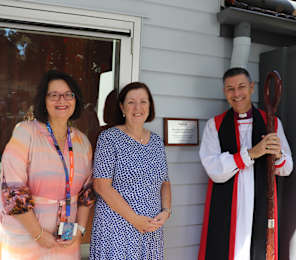The Medical Journal of Australia (MJA) has published an article on the COVID-19 outbreak at BaptistCare’s Dorothy Henderson Lodge in Sydney from March to May – and it is worth a read.
 The piece – by Professor Gwendolyn Gilbert (pictured right), a Clinical Professor of Medicine (Immunology & Infectious Diseases) at the Westmead Institute for Medical Research – finds that the support of experienced IPC professionals and medical practitioners was key to responding to the outbreak which led to the infections of 13 residents and five staff.
The piece – by Professor Gwendolyn Gilbert (pictured right), a Clinical Professor of Medicine (Immunology & Infectious Diseases) at the Westmead Institute for Medical Research – finds that the support of experienced IPC professionals and medical practitioners was key to responding to the outbreak which led to the infections of 13 residents and five staff.
A crisis team of Lodge managers and Northern Sydney Local Health District senior public health and infection prevention and control (IPC) staff, was formed immediately after the first staff member tested positive, with residents in the wing where the carer had worked isolated and IPC precautions implemented including approximately 800 sets of PPE used each day.
The next day, an IPC specialist from the NSW Clinical Excellence Commission took charge of IPC with standard precautions introduced for everyone entering the facility, plus additional contact and droplet precautions for staff in close contact with residents.
Over the next two days, all residents were confined to their rooms and all personal care staff were furloughed to home quarantine, during which two more staff members and four residents were diagnosed with COVID‐19, including two residents who were already in hospital.
Home forced to rely on skeleton staff until agency staff provided
A skeleton staff of BaptistCare managers and other volunteer staff – who had not had close contact with residents – provided care for several days until agency staff could be engaged.

Enhanced cleaning, laundry and waste collection and food delivery practices were introduced, while symptomatic residents and staff were tested.
Another four residents and one staff member tested positive, with all of the cases believed to have been infected before the IPC protocols were introduced.
By 20 March, three of the home’s 76 residents had died from COVID‐19, five were in hospital, and the remaining 68 had been confined to their rooms for 17 days.
“They were becoming increasingly distressed by isolation and immobility, and a few with dementia repeatedly wandered from their rooms,” the piece states. “Clearly, there was some urgency to provide relief. Although they had no acute symptoms, all were tested for COVID‐19, with a view to allowing them brief periods of supervised exercise outside their rooms if test results were negative.”
But five tested positive, one of whom later died in hospital. 10 days later, three more residents showed symptoms and two died.
In the end, 16 residents (21%) were infected with six passing away.
Residents confined to rooms for over six weeks
The author notes the serious adverse effects being confined to rooms for more than six weeks had on residents, despite efforts from staff to mitigate them.
“Some became depressed, withdrawn or physically deconditioned and refused to eat or, when later given the opportunity, leave their rooms. This highlights the importance of mobilisation and resuming family contacts as soon as possible,” Professor Gilbert writes.
Interestingly, the article says while hospital admission of residents with COVID‐19 to hospital was appropriate early in the outbreak, most residents who tested positive wanted to be care for in the home.
“Decisions about hospital transfer of aged care residents should consider their medical needs and preferences and the facility’s capacity to care for them safely,” the article states.
Professor Gilbert also emphasises the importance of immediate and repeated testing for all residents and staff and tailored IPC training for staff involving all aged care workers including personal care, nursing, agency and support staff.










